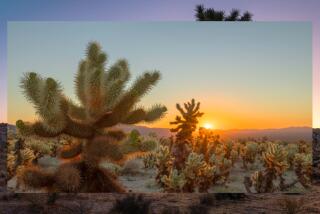Step-by-Step Account of a North Rim Descent
- Share via
GRAND CANYON NATIONAL PARK, Ariz. — “Let’s get this over with so I can say I’ve ridden a mule.”
The New Jersey dude was bicycling through canyon country, doing the Bryce, Zion, Grand Canyon circuit. At the North Rim of the Grand Canyon, he finally was persuaded to get on a mule. (He was already at home in a bicycle saddle.)
The trip was a one-day venture on the uncrowded North Kaibab Trail, a five-mile descent to Roaring Springs. The route, first tracked by Paiute Indians, explores a precipitous side canyon that follows Bright Angel Creek. It offers an up-close perspective of the canyon that is totally unlike the wide plateaus and panoramas of the South Rim.
At 7:30 a.m. each morning, up to 20 mule riders assemble at Grand Canyon Lodge to be bused to the trailhead. A guide advises that this mule trip is less strenuous than the two-day expedition from South Rim to Phantom Ranch and back, but it will give a thrill or two.
And that’s a fact. The trail drops 4,000 feet, wriggling through shaded woods and along cliff-hanger ledges where a rider can touch the fossils in the faces of ancient rock.
Given their lead, the sure-footed Jacks and Jennies measure their way around “oh-my-gawd-turns,” paying no attention to the depths below or towering pinnacles above. Riders tend to clutch their saddle horns while clinging to windblown hats and dust-covered cameras.
If a mule tries to nibble something green, wrangler Mike Whitney warns: “When you lag behind, mules spook, and that leaves a mess of broken bones and brains on the trail.”
One curious rider is told her animal is named Short Cut because his parachute saddle helps him jump to the South Rim. Tall tales are as traditional as mule riding, harking back to a time when visitors wouldn’t have considered walking for the fun of it.
If there were no canyon here, it would still be exhilarating backcountry. Scents of pine and wafts of chill air suggest mountains, not desert. The Kaibab Plateau is 1,000 feet higher than the South Rim’s Coconino Plateau, and noticeably cooler. Because of heavy winter snowfall, the park’s limited facilities here are open only from mid-May to mid-October. Even in summer it seems remote.
The lodge sits tight on the rimrock, 5,700 feet above the unseen canyon floor. It serves as a reservations and Park Service information center, and its dining room overlooks the gorge, so sunsets are reserved in advance. The patio offers front-row seats as well.
This, the only lodge on the North Rim, actually provides no lodging at all, but anchors a complex of rustic, comfortable cabins among the pines. Frills consist of a gift shop, cafeteria and snack bar. There is a grocery store at the nearby campground.
The first lodge was opened in 1928 by the Utah Parks Co., a subsidiary of Union Pacific Railroad, which was boosting tourism in national parks. It burned four years later, but the present structure is faithful to the original’s “Early National Park” architecture, including rough-hewn limestone walls and high-timbered ceilings.
Not far from the lodge is Bright Angel Point, with its famous view of the Deva, Brahma and Zoroaster temples. These are the buttes engraved on a two-cent U.S. postage stamp issued in 1934.
Reaching the bottom of the canyon, riders dismount for a picnic lunch. At this point, some tenderfoots may have begun to feel tender in other spots. A dip in the swirling waters of Roaring Springs cascade is numbing. This sparkling clear spring is the water source for the entire park.
By the return climb, the mules seem like guardian angels, even as they nose out over the brink for frequent rest stops--”so they can see where their front feet are.” Their routine is one-speed all the way, a steady trudge toward an alfalfa supper back at the stable.
The cyclist looked forward to something more soothing. He had to get back on his two-wheeler the next day.
More to Read
Sign up for The Wild
We’ll help you find the best places to hike, bike and run, as well as the perfect silent spots for meditation and yoga.
You may occasionally receive promotional content from the Los Angeles Times.






